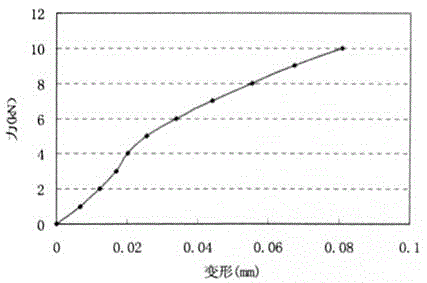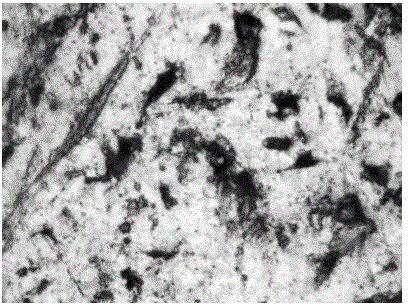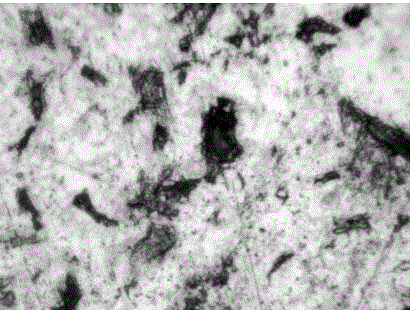Hard aluminum alloy for metal die casting of precision electronic product structural member
- Summary
- Abstract
- Description
- Claims
- Application Information
AI Technical Summary
Problems solved by technology
Method used
Image
Examples
Embodiment 1
[0042] Step 1: The ingredients are shown in Table 1-1.
[0043]
[0044] Step 2: Melting
[0045] The alloy is smelted in a graphite crucible resistance furnace. Aluminum-silicon alloy, aluminum-manganese alloy, aluminum-nickel alloy, aluminum-chromium alloy and pure aluminum ingot are loaded at room temperature at the same time; aluminum-copper alloy and pure zinc ingot are added at 720°C; aluminum-titanium-boron rare-earth alloy is added at 740°C and stirred for 5 minutes. Use C 2 Cl 6 For refining with refining agent, the amount of flux added during refining is about 2% of the weight of the raw material. Stir up and down with a refining spoon until the liquid surface becomes a mirror surface. After standing for 10 minutes, remove the slag, add a small amount of covering agent, add pure magnesium ingot, and stand still. Leave it for 5 minutes, stir evenly, and then die-cast at 720°C.
[0046] Step 3: Die casting manufacturing
[0047] 1600N horizontal cold-chamber die-casting mac...
Embodiment 2
[0053] Step 1: The ingredients are shown in Table 2-1.
[0054]
[0055] Step 2: Melting
[0056] The alloy is smelted in a graphite crucible resistance furnace. Aluminum-silicon alloy, aluminum-manganese alloy, aluminum-nickel alloy, aluminum-chromium alloy, aluminum-vanadium alloy and pure aluminum ingot are simultaneously loaded into the furnace at room temperature; aluminum-copper alloy and pure zinc ingot are added at 720°C; after aluminum-titanium-boron rare-earth alloy is added at 740°C Stir for 5min. Use C 2 Cl 6 For refining with refining agent, the amount of flux added during refining is about 2% of the weight of the raw material. Stir up and down with a refining spoon until the liquid surface becomes a mirror surface. After standing for 10 minutes, remove the slag, add a small amount of covering agent, add pure magnesium ingot, and stand still. Leave it for 5 minutes, stir evenly, and then die-cast at 720°C.
[0057] Step three:
[0058] 1600N horizontal cold-chambe...
Embodiment 3
[0064] Step 1: The ingredients are shown in Table 3-1.
[0065]
[0066] Step 2: Melting
[0067] The alloy is smelted in a graphite crucible resistance furnace. Aluminum-silicon alloy, aluminum-manganese alloy, aluminum-nickel alloy, aluminum-chromium alloy, aluminum-vanadium alloy and pure aluminum ingot are simultaneously loaded into the furnace at room temperature; aluminum-copper alloy and pure zinc ingot are added at 720°C; after aluminum-titanium-boron rare-earth alloy is added at 740°C Stir for 5min. Use C 2 Cl 6 For refining with refining agent, the amount of flux added during refining is about 2% of the weight of the raw material. Stir up and down with a refining spoon until the liquid surface becomes a mirror surface. After standing for 10 minutes, remove the slag, add a small amount of covering agent, add pure magnesium ingot, and stand still. Leave it for 5 minutes, stir evenly, and then die-cast at 720°C.
[0068] Step three:
[0069] 1600N horizontal cold-chamber...
PUM
| Property | Measurement | Unit |
|---|---|---|
| Width | aaaaa | aaaaa |
| Adhesion | aaaaa | aaaaa |
| Adhesion | aaaaa | aaaaa |
Abstract
Description
Claims
Application Information
 Login to View More
Login to View More - R&D
- Intellectual Property
- Life Sciences
- Materials
- Tech Scout
- Unparalleled Data Quality
- Higher Quality Content
- 60% Fewer Hallucinations
Browse by: Latest US Patents, China's latest patents, Technical Efficacy Thesaurus, Application Domain, Technology Topic, Popular Technical Reports.
© 2025 PatSnap. All rights reserved.Legal|Privacy policy|Modern Slavery Act Transparency Statement|Sitemap|About US| Contact US: help@patsnap.com



